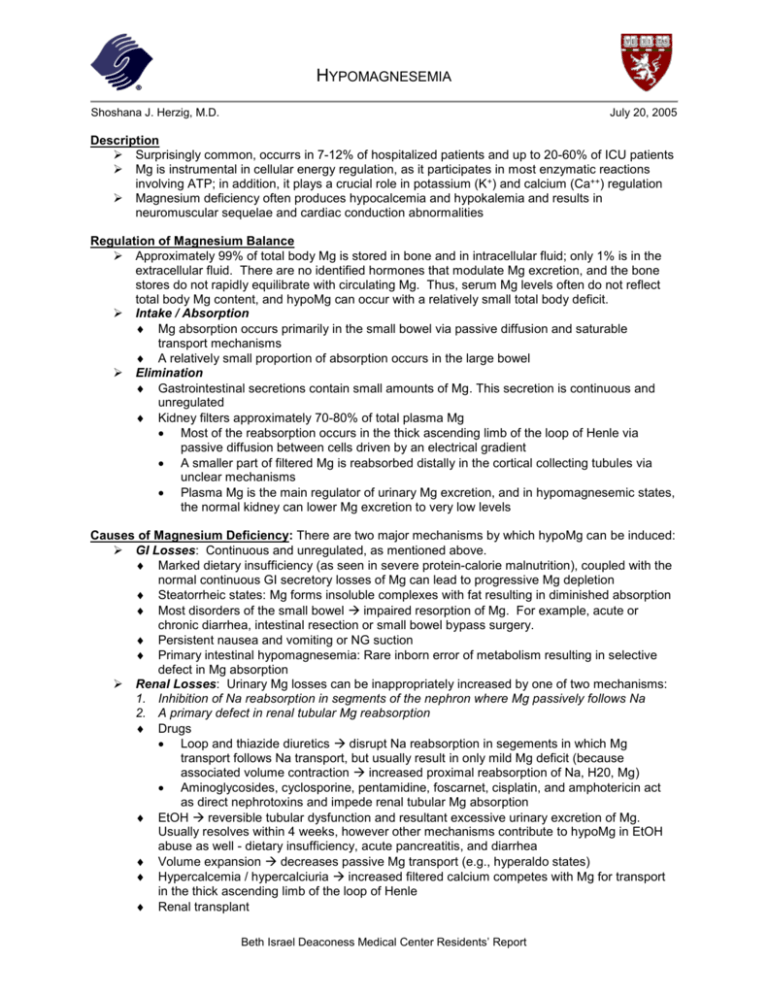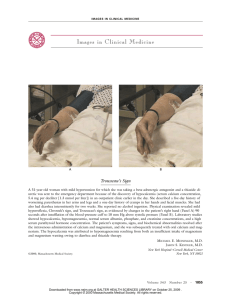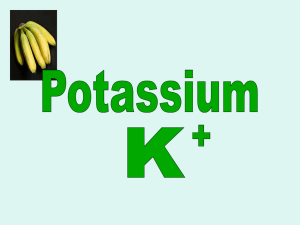Hypomagnesemia
advertisement

HYPOMAGNESEMIA Shoshana J. Herzig, M.D. July 20, 2005 Description Surprisingly common, occurrs in 7-12% of hospitalized patients and up to 20-60% of ICU patients Mg is instrumental in cellular energy regulation, as it participates in most enzymatic reactions involving ATP; in addition, it plays a crucial role in potassium (K+) and calcium (Ca++) regulation Magnesium deficiency often produces hypocalcemia and hypokalemia and results in neuromuscular sequelae and cardiac conduction abnormalities Regulation of Magnesium Balance Approximately 99% of total body Mg is stored in bone and in intracellular fluid; only 1% is in the extracellular fluid. There are no identified hormones that modulate Mg excretion, and the bone stores do not rapidly equilibrate with circulating Mg. Thus, serum Mg levels often do not reflect total body Mg content, and hypoMg can occur with a relatively small total body deficit. Intake / Absorption Mg absorption occurs primarily in the small bowel via passive diffusion and saturable transport mechanisms A relatively small proportion of absorption occurs in the large bowel Elimination Gastrointestinal secretions contain small amounts of Mg. This secretion is continuous and unregulated Kidney filters approximately 70-80% of total plasma Mg Most of the reabsorption occurs in the thick ascending limb of the loop of Henle via passive diffusion between cells driven by an electrical gradient A smaller part of filtered Mg is reabsorbed distally in the cortical collecting tubules via unclear mechanisms Plasma Mg is the main regulator of urinary Mg excretion, and in hypomagnesemic states, the normal kidney can lower Mg excretion to very low levels Causes of Magnesium Deficiency: There are two major mechanisms by which hypoMg can be induced: GI Losses: Continuous and unregulated, as mentioned above. Marked dietary insufficiency (as seen in severe protein-calorie malnutrition), coupled with the normal continuous GI secretory losses of Mg can lead to progressive Mg depletion Steatorrheic states: Mg forms insoluble complexes with fat resulting in diminished absorption Most disorders of the small bowel impaired resorption of Mg. For example, acute or chronic diarrhea, intestinal resection or small bowel bypass surgery. Persistent nausea and vomiting or NG suction Primary intestinal hypomagnesemia: Rare inborn error of metabolism resulting in selective defect in Mg absorption Renal Losses: Urinary Mg losses can be inappropriately increased by one of two mechanisms: 1. Inhibition of Na reabsorption in segments of the nephron where Mg passively follows Na 2. A primary defect in renal tubular Mg reabsorption Drugs Loop and thiazide diuretics disrupt Na reabsorption in segements in which Mg transport follows Na transport, but usually result in only mild Mg deficit (because associated volume contraction increased proximal reabsorption of Na, H20, Mg) Aminoglycosides, cyclosporine, pentamidine, foscarnet, cisplatin, and amphotericin act as direct nephrotoxins and impede renal tubular Mg absorption EtOH reversible tubular dysfunction and resultant excessive urinary excretion of Mg. Usually resolves within 4 weeks, however other mechanisms contribute to hypoMg in EtOH abuse as well - dietary insufficiency, acute pancreatitis, and diarrhea Volume expansion decreases passive Mg transport (e.g., hyperaldo states) Hypercalcemia / hypercalciuria increased filtered calcium competes with Mg for transport in the thick ascending limb of the loop of Henle Renal transplant Beth Israel Deaconess Medical Center Residents’ Report Post-obstructive uropathy diuresis ATN Bartter’s syndrome / Gitelman’s syndrome Other Acute pancreatitis Saponification of magnesium (in addition to calcium) in the necrotic fat Thyrotoxicosis effects redistribution of Mg rather than total body depletion Hungry bone syndrome: s/p parathyroidectomy, get increased Mg uptake by the renewing bone Surgery reported in CABG and liver transplant and may be secondary to chelation by free fatty acids or citrate-rich blood products Laboratory Manifestations Serum magnesium level < 1.0 mg/dL is considered severe hypomagnesemia Level between 1.1 and 1.4 mg/dL is considered mild to moderate hypomagnesemia A normal serum Mg level does not exclude total body Mg deficiency Hypocalcemia most classical sign of severe hypomagnesemia Mg deficiency is reportedly the most common cause of hypocalcemia in the general hospital population Postulated mechanisms include bone resistance to PTH, and, in more severe hypomagnesemia, decreased PTH secretion Hypokalemia Mechanism in part reflects the underlying disorders that cause concomitant Mg++ and K+ loss (such as diuretic use and severe diarrhea) In addition, hypomagnesemia induces increased K+ secretion in the loop of Henle This hypokalemia may be refractory to K+ supplementation without treatment of the Mg++ deficit 24 hour urine and random urine may aid in distinguishing GI from renal Mg losses Mg++ excretion > 10-30 mg/24 hours in the setting of hypoMg is consistent with renal wasting Fractional excretion of Mg (FEMg) > 2% in patient with normal renal function suggests renal Mg wasting: FEMg = [(UMg x PCr) / (0.7PMg x Ucr)] x 100 Clinical Manifestations: Often difficult to separate from those related to accompanying hypocalcemia Neuromuscular lethargy, confusion, tremor, fasciculations, ataxia, nystagmus, tetany, seizures, Chvostek sign, Trousseau sign Cardiovascular ECG Widened QRS complexes and peaked T waves in moderate hypoMg, progressing to prolonged PR, further QRS widening, and diminution of T waves in more severe disease Increased atrial and ventricular arrhythmias, especially during myocardial ischemia or cardiopulmonary bypass Treatment In patients with normal renal function, there is little risk of inducing hyperMg, as excess Mg is readily excreted; however, replete with caution in patients with impaired renal function Severe, symptomatic hypomagnesemia 1-2 gm MgSO4 diluted to 100 mL and administered over 15 minutes, followed by infusion of 6 gm MgSO4 in 1L or more administered over 24 hours (2 cc ampule of MgSO 4 = 1 gm MgSO4 = 98 mg elemental Mg = 8 meq elemental Mg ) Typical deficit for depleted adult is 75-150 meq, thus the MgSO4 infusion often needs to be continued for 3-7 days for full repletion Serum Mg should be measured every 24 hours and the infusion rate adjusted to maintain serum Mg within normal range; deep tendon reflexes should be monitored frequently as hyporeflexia is indicative of hypermagnesemia Alternative parenteral regimens include IM replacement (ouch) In some situations, Mg replacement alone may be relatively ineffective, since raising the plasma Mg will lead to increased Mg excretion. In these situations, K-sparing diuretics (ex, amiloride) should be used adjunctively to help decrease Mg excretion Mild or chronic hypmagnesemia Mg-oxide to provide 240 mg of elemental Mg po qd or bid Major adverse effect is diarrhea Beth Israel Deaconess Medical Center Residents’ Report








